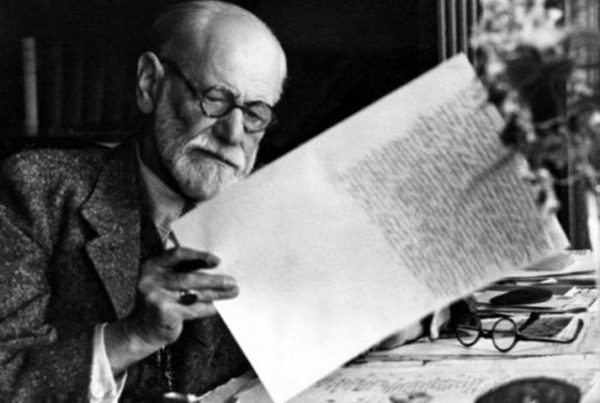
Freud y sus contribuciones
Freud, trabajando con pacientes histéricos
El Dr. Freud, llegó a comprender que los síntomas que padecían encarnaban un significado que estaba simultáneamente oculto y revelado.
Así, con el tiempo aprendió que todos los síntomas neuróticos eran mensajeros que llevaban contenido psíquico reprimido (y por tanto inconsciente).
Ello le llevó a desarrollar su “cura hablada”, que revolucionó la interacción entre paciente y terapeuta. Freud veía a sus pacientes seis días a la semana, escuchando y respondiendo a lo que le decían, mientras estaban acostados en un diván.
Los pacientes eran invitados a decir cualquier cosa que se les pasara por la cabeza, proporcionándole a Freud asociaciones que les llevaban a experiencias, deseos y fantasías infantiles reprimidas que habían dado lugar a conflictos inconscientes; una vez traídos a la conciencia, estos conflictos podrían analizarse y luego disolverse los síntomas.
Finalmente, este procedimiento se convirtió no sólo en un potente método de tratamiento sino también en una herramienta eficaz para estudiar la psique humana, lo que condujo al desarrollo de una teoría psicoanalítica cada vez más sofisticada sobre cómo funciona la mente y, en los últimos años, a estudios conjuntos y comparativos en las nuevas tecnologías. campo del neuropsicoanálisis.

Imagen: algunas de las antigüedades y colección de libros de Sigmund Freud
Freud y sus innovaciones
Los primeros descubrimientos de Freud lo llevaron a algunos conceptos nuevos e innovadores:
Lo inconsciente
Sobre todo, la vida psíquica va más allá de lo que somos conscientes, también más allá de lo que es preconsciente, en el sentido de aquello de lo que podríamos tomar conciencia una vez que intentamos pensar en ello.
Una gran parte de nuestra mente es inconsciente y sólo es accesible con el psicoanálisis
Las experiencias de la primera infancia
Son una amalgama de fantasía y realidad.
Entonces, para Freud, se caracterizan por deseos apasionados, impulsos indómitos y ansiedades infantiles.
Por ejemplo, el hambre despierta el deseo de devorarlo todo, pero también el miedo de ser devorado por todos los demás; el deseo de tener el control y ser independiente está vinculado al miedo a ser manipulado o abandonado; separarse de una persona importante que lo cuida podría llevar a permanecer expuesto, indefenso y solo; amar a uno de los padres podría correr el riesgo de perder el amor del otro.
Porque, los deseos y miedos tempranos dan lugar a conflictos que, cuando no pueden resolverse, se reprimen y se vuelven inconscientes.
Desarrollo psicosexual
En línea con esto, Sigmund Freud reconoció que la maduración progresiva de las funciones corporales centradas en las zonas erógenas (boca, ano, genitales) va acompañada de placeres y miedos experimentados en la relación con los objetos que lo cuidan, y estos estructuran el desarrollo de la mente del niño. .
El complejo de Edipo
Así, es el complejo central de todas las neurosis .
Un niño de cuatro a seis años toma conciencia de la naturaleza sexual de la relación de los padres, de la que están excluidos.
Consecuentemente, surgen sentimientos de celos y rivalidad que es necesario resolver, junto con las preguntas de quién es hombre y quién mujer, quién puede amar y casarse con quién, cómo se hacen y nacen los bebés y qué puede hacer o hacer el niño en comparación con el adulto. no hacer.
Por tanto, la resolución de estas desafiantes preguntas moldeará el carácter de la mente adulta y del superyó (ver más abajo en El yo, el ello y el superyó)
La represión
Entonces, se trata de la fuerza que mantiene en el inconsciente fantasías peligrosas relacionadas con partes no resueltas de los conflictos infantiles
Los sueños son cumplimientos de deseos
La mayoría de las veces expresan el cumplimiento de deseos o fantasías sexuales infantiles. Al aparecer disfrazados (como escenas absurdas, extrañas o incoherentes) requieren análisis para revelar su significado inconsciente.
Freud llamó a la interpretación de los sueños el «camino reggio» hacia lo inconsciente
La transferencia
Tendencia omnipresente de la mente humana a ver e identificar nuevas situaciones dentro de los patrones de experiencias anteriores.
En psicoanálisis, la transferencia ocurre cuando un paciente ve al analista como una figura paterna, con quien puede volver a experimentar los principales conflictos o traumas infantiles como si estuvieran dentro de la relación original entre padre e hijo
Asociación libre
Describe el surgimiento de pensamientos, sentimientos y fantasías cuando están desinhibidos por las restricciones causadas por el miedo, la culpa y la vergüenza
El Ego, el Ello y el Superyó
Ego es la sede principal de la conciencia, el agente de la mente que ejerce las represiones e integra y consolida diversos impulsos y tendencias antes de que se traduzcan en acción.
Ello es la parte inconsciente de la mente, el lugar de los rastros de la memoria reprimidos e incognoscibles de los primeros años de vida.
Superego es la guía y la conciencia de la mente, un retenedor de prohibiciones que cumplir y de ideales por los que luchar
Fuente: traducción adaptada de «About Psychoanalysis». International Psychoanalytic Association website
Artículos relacionados
¿Qué es el psicoanálisis según Freud?
¿Qué es lo inconsciente para Freud?
El método de Freud para interpretar los sueños
Consulta Psicoanálisis Madrid
Zona (Castellana – Salamanca)
A cargo de Susana L. Ruiz (saber más aquí)
Presencial & online
España & internacional
info@bienestarpsicoanalisis.com









